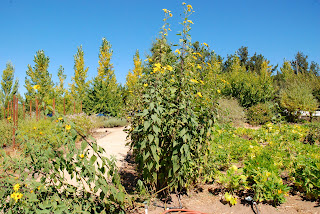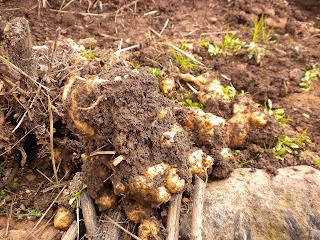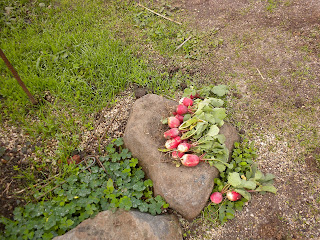definition of "grow" (from the dictionary)
[groh] verb, grew, grown, grow·ing.
verb (used without object)
1. to increase by natural development, as any living organism or part by assimilation of nutriment; increase in size or substance.
2. to form and increase in size by a process of inorganic accretion, as by crystallization.
3. to arise or issue as a natural development from an original happening, circumstance, or source: Our friendship grew from common interests.
4.to increase gradually in size, amount, etc.; become greater or larger; expand: His influence has grown.
5.to become gradually attached or united by or as if by growth: The branches of the trees grew together, forming a natural arch.
The farm is all about growing—obviously the vegetables we plant,
but also about our own growth. Others have written about how
"gardening can be considered a metaphor for life."
And the more time and effort we spend farming, the more we understand this.
Executive Chef John Toulze has talked before about how "farming teaches us how to cook," as we pay attention to the seasons of the farm which may or may not
fit the season as we expect. The ongoing work at the farm teaches us patience in broader ways as well—applied as we work the land, plant the seeds
and tend our plants as they grow according to their own plan.
 |
| John planting seeds for cover crops |
 |
| some growing better than others |
Then like most important lessons in life, the patience we bring
to this project somehow becomes a greater part of our lives.
"The thing about gardening is that you realize you can’t rush things.
A
seed takes a certain amount of time to sprout, no matter what you do."
 |
| the collard plants seem to be thriving |
 |
| broccoli starting to grow |
"A plant or tree takes a certain amount of time to grow, flower,
or bear fruit, no matter what you do—some things grow as we intend, others do not."
This may seem like a simple concept, but it is often challenging
to apply to other areas of our lives.
Which is why gardening is a good reminder to us in how to live.
Because the garden has its own plan—and the plants, with perhaps
a bit of help from us, and a lot of nurturing from nature will grow as they will.
Some plants are flourishing at the farm and some are not doing as well.
 |
| the lower beds when they were just planted |
 |
| most of the plants are beginning thriving |
 |
| but we are not sure about the beets yet |
This is especially true at this time of year.
We worked hard to get the winter crops planted before the rains
especially the cover crops necessary to nourish the soil
throughout the winter in preparation for spring planting.
 |
| the clover beds will do well this winter |
 |
| and most of the vegetables in the lower beds |
 |
| should soon be on the menu at the girl & the fig |
 |
| radishes are always growing at the farm photo by Steven Krause |
 |
| to keep up with demand for our heirloom radish starter, perennial favorite on the menu at "the fig." |
 |
| Chinese snow peas |
 |
| and our lush kale always thrives at the farm |
 |
|
on the menu
now at the
girl & the fig:
braised short rib, yukon gold potato
croquettes, braised kale, natural jus
|
Do you find gardening meditative?
Does your time in the garden help you clear your head or find creative solutions?
Or, does it just help you relax as you muse on what to cook with what you grow?









































